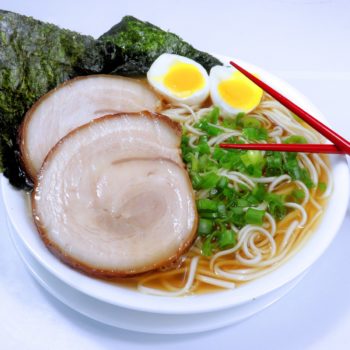If you want to learn how to make authentic Japanese ramen you have come to the right place! This is your complete guide for each step of the ramen-making process, including the tonkotsu (pork bone) broth, the shoyu tare, the rolled pork chashu, and the perfectly soft-boiled egg.
Authentic Japanese shoyu ramen is something that I have been working on perfecting for years! My husband spent time in Japan and the one thing he was obsessed with was the ramen. When he got back home he was hell-bent on finding a bowl that stood up, but every ramen restaurant he went to let him down one way or another. So, I made it my personal mission to recreate it for him! I can't tell you how many times I tried and failed, which he was always very honest with me about. After A LOT of research and A LOT of trial and error, he has finally dubbed this recipe as perfect, and he loves bragging about it to anyone who will listen.
I'm not going to lie, it is a lengthy process to make it, but it's also fun and your house will smell amazing throughout! To make it easier, just tackle one step at a time and enjoy spending a few days making it. It's worth all of the effort in the end.
WHAT BROTH IS USED FOR RAMEN
The base for ramen broth is called tonkotsu, which is made from simmering pork bones and aromatics for hours. The type of seasoning is what classifies the type of broth. Shoyu is the most common type of broth and is seasoned with soy sauce. Shio ramen is seasoned with salt, and miso ramen is seasoned with miso, which is a fermented bean paste.
MAKE THE PORK BONE BROTH
- Start with 4 pounds of pork neck bones. You should be able to find them in the frozen section at most butcher shops, I've also seen them at a few grocery stores. There's no need to thaw the bones before making the broth.
- Soak the bones in water for 1 hour to remove any impurities. Drain and clean the bones. Add the bones to a large stockpot along with one leek and 8 cloves of garlic, smashed. Cover with water and bring to a boil.
- Boil rapidly for 15 minutes. Use a strainer to skim off any of the scum that floats to the surface.
- Reduce the heat to a low simmer and simmer for at least 5 hours, but 12 hours or overnight is preferred. The longer the broth simmers the more flavorful it will be.
- Strain the mixture and discard the bones and aromatics. Any broth you aren't using right away can be kept in the fridge for 1 week or kept frozen for 6 months.
WHAT MEAT IS USED FOR SHOYU RAMEN
The most popular meat used in authentic Japanese ramen is pork belly. It's a fatty, tough cut of meat that becomes very tender when braised slowly in liquid for hours. You can find it at your local butcher shop or some Asian markets. Rolling the pork into a log helps keep it tender and juicy on the inside and also makes for a better presentation.
To roll the pork, start with the skin side down, and roll it into a tight log. Tie at one end with kitchen twine leaving about 2 inches of loose twine. Continue wrapping around with the twine going to the other end of the pork. Make your way back to the starting end and tie it off with the loose piece of twine.
MAKE THE PORK CHASHU
In a large pot, heat oil and add the rolled pork. Brown for 2-3 minutes on all sides to get a nice, even sear. Add in soy sauce, sake, broth, green onions, shallots, and smashed garlic and bring to a boil. The pork should be about halfway submerged with the liquid. Cover and simmer on low for 2 hours, rotating the pork every 30 minutes. Allow the pork to cool completely in the fridge before cutting into thin slices. Using a bread knife makes slicing easier.
FOR THE SHOYU TARE (SEASONING)
In a medium pot, add soy sauce, sake, mirin, rice vinegar, and brown sugar. Keep simmering on low and set aside until ready to use.
AUTHENTIC JAPANESE RAMEN NOODLES
You can find authentic Japanese ramen noodles at your local Asian market in the frozen section or in the dried noodles area. If you're having trouble finding them just ask one of the employees to show you. Make sure they are real ramen noodles and not the dried packaged kinds that college kids make. The noodles cook quickly, about 1 to 3 minutes in boiling water.
FOR THE SOFT BOILED EGG
For perfect soft boiled eggs, bring 3 inches of water to a boil in a large pot. Lower the heat and use a spoon to very carefully and gently lower the eggs into the water. Do this slowly so they don't crack. Once you have all of the eggs added to the pot, increase the heat back to medium and set a timer to boil for 6 - 7 minutes. Remove the eggs and immediately transfer to a bowl of ice water to stop the cooking.
ASSEMBLE THE SHOYU RAMEN
Heat the bone broth in a small saucepan and add the shoyu seasoning slowly. Start with 2 tablespoons for every 1 cup of broth. Pour the shoyu broth over the cooked noodles and add the sliced chashu, soft boiled egg, green onion, and sesame seeds. Serve immediately.
Other Ramen Toppings:
- Dried seaweed
- Steamed cabbage
- Dried shitake mushrooms
- Bean sprouts
- Bamboo shoots
- Corn
📖 RECIPE

Authentic Japanese Shoyu Ramen
Ingredients
For the Pork Bone Broth
- 3½-4 lbs. pork bones
- 2 leeks, ends trimmed and roots cut off
- 8 cloves garlic, unpeeled, smashed
- 8 cups water
For the Rolled Chashu
- 1½ lbs. pork belly
- 1 tablespoon olive oil
- ¾ cup soy sauce
- 1 cup dry, clear sake
- 1 cup water or broth (use the pork bone broth if you have it)
- 3 green onions
- 4 cloves garlic, peeled and smashed
- 2 shallots
For the Shoyu Tare:
- ½ cup soy sauce
- ¼ cup mirin
- 2 tablespoon dry sake
- 1 teaspoon brown sugar
- 1 teaspoon rice vinegar
Ramen Assembly and Toppings:
- Japanese ramen noodles
- 2-3 green onions, chopped
- 2 large eggs
- dried seaweed
- roasted sesame seeds
Instructions
For the Tonkotsu Pork Bone Broth:
- Soak the pork bones for 1 hour to remove any impurities.
- Cut the leeks in half and clean all of the layers well to remove any dirt trapped inside.
- Drain and clean the pork bones well. In a large pot, add the pork bones, leeks, and smashed garlic,. Add enough water to the pot to cover the bones. Bring the water to a boil and boil rapidly for 15 minutes, then reduce to a simmer and cover with a lid. Simmer the broth, covered, for at least 5 hours, but preferably 12 hours or up to overnight. The longer you simmer the broth the more flavorful it will be.
- Drain the broth through a colander into a large bowl. Then strain it again through a fine-mesh strainer to remove any bits of pork or vegetables.
For the Rolled Pork Belly:
- Roll the pork into a log starting with the fatty side on the outside. Using kitchen twine, tightly wrap one end of the log and tie with a knot, leave a little extra string loose. Take the twine and wrap it across to the other end of the log. Wrap tightly on the other end and then continue wrapping tightly as you make your way back to the beginning end. Tie with the loose piece of string.
- Heat the oil in a medium-large pot. Once the oil is hot, add the rolled pork and sear on all sides for 2-3 minutes, about 15 minutes total. You want to render the fat out and all sides of the pork to have a nice, even brown sear.
- Lower the heat slightly and add the soy sauce, sake, broth, green onions, shallots, and garlic. The pork should be about halfway submerged. Bring to a boil, then cover with a lid and reduce the heat to a simmer. Simmer for 2 hours, flip the pork every 30 minutes.
Make the Tare:
- In a medium pot, combine the soy sauce, mirin, sake, sugar, and rice vinegar. Bring to a boil and then simmer, set aside until ready to use.
For the Soft-Boiled Egg:
- Bring 3" of water to a boil in a large pot. Lower the heat and use a spoon to very carefully and gently lower the eggs into the water. Once all of the eggs are added, increase the heat to medium, set a timer, and boil for 6-7 minutes. Immediately transfer the eggs to a bowl of ice water to stop the cooking.
Assemble the Ramen:
- Cook the ramen noodles according to the package instructions. Add to a large bowl along with dried seaweed. Pour in your desired amount of broth and tare and top with thin slices of the pork belly, soft-boiled egg, sliced green onions, and sesame seeds. Serve warm.
Nutrition





















Michael
wow! this recipe is amazing!